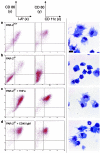Protease-activated receptor-2 signaling triggers dendritic cell development
- PMID: 12759239
- PMCID: PMC1868121
- DOI: 10.1016/S0002-9440(10)64316-7
Protease-activated receptor-2 signaling triggers dendritic cell development
Abstract
Dendritic cells (DC) are potent antigen-presenting cells that govern the effector cell responses of the immune system. DC are thought to continuously develop from circulating progenitors in a process that is accelerated by inflammatory stimuli. However, the physiological signals that regulate the development of DC from precursor cells have not been well defined. Here we show that a serine protease acting via protease-activated receptor-2 (PAR-2) stimulates the development of DC from bone marrow progenitor cells cultured in granulocyte-macrophage colony-stimulating factor and IL-4. DC fail to develop in bone marrow cultures treated with soy bean trypsin inhibitor, a serine protease inhibitor, but this inhibition is overcome by a PAR-2 agonist peptide. DC do not spontaneously develop from the bone marrow of PAR-2-deficient mice, but can be stimulated to do so by inflammatory mediators. These results suggest that endogenous serine proteases stimulate DC development in vitro. Thus, serine proteases may help trigger adaptive immune responses in vivo.
Figures




Similar articles
-
Analysis of maturation states of rat bone marrow-derived dendritic cells using an improved culture technique.Histochem Cell Biol. 2002 Apr;117(4):351-62. doi: 10.1007/s00418-002-0384-4. Epub 2002 Feb 16. Histochem Cell Biol. 2002. PMID: 11976908
-
Contrasting effects of TGF-beta 1 and TNF-alpha on the development of dendritic cells from progenitors in mouse bone marrow.Stem Cells. 1997;15(2):144-53. doi: 10.1002/stem.150144. Stem Cells. 1997. PMID: 9090791
-
Type I IFN regulate DC turnover in vivo.Eur J Immunol. 2009 Jul;39(7):1807-18. doi: 10.1002/eji.200939233. Eur J Immunol. 2009. PMID: 19544312
-
Bone marrow-derived immature dendritic cells prime in vivo alloreactive T cells for interleukin-4-dependent rejection of major histocompatibility complex class II antigen-disparate cardiac allograft.Transplantation. 2003 Feb 15;75(3):407-13. doi: 10.1097/01.TP.0000044172.19087.22. Transplantation. 2003. PMID: 12589166
-
In vitro hematopoiesis reveals a novel dendritic-like cell present in murine spleen.Curr Stem Cell Res Ther. 2013 Sep;8(5):365-9. doi: 10.2174/1574888x113089990050. Curr Stem Cell Res Ther. 2013. PMID: 23971833 Review.
Cited by
-
Expanding the clinical indications for α(1)-antitrypsin therapy.Mol Med. 2012 Sep 7;18(1):957-70. doi: 10.2119/molmed.2011.00196. Mol Med. 2012. PMID: 22634722 Free PMC article. Review.
-
Initial support for the hypothesis that PAR2 is involved in the immune response to Nippostrongylus brasiliensis in mice.Parasitol Res. 2007 Jun;101(1):105-9. doi: 10.1007/s00436-007-0467-1. Epub 2007 Feb 14. Parasitol Res. 2007. PMID: 17458579
-
Protease Activated Receptor 4 as a Novel Modulator of Regulatory T Cell Function.Front Immunol. 2019 Jun 18;10:1311. doi: 10.3389/fimmu.2019.01311. eCollection 2019. Front Immunol. 2019. PMID: 31275306 Free PMC article.
-
Mast cell plasticity and sphingosine-1-phosphate in immunity, inflammation and cancer.Mol Immunol. 2015 Jan;63(1):104-12. doi: 10.1016/j.molimm.2014.03.018. Epub 2014 Apr 22. Mol Immunol. 2015. PMID: 24766823 Free PMC article. Review.
-
Protease-activated receptors in health and disease.Physiol Rev. 2023 Jan 1;103(1):717-785. doi: 10.1152/physrev.00044.2021. Epub 2022 Jul 28. Physiol Rev. 2023. PMID: 35901239 Free PMC article. Review.
References
-
- Steinman RM: The dendritic cell system and its role in immunogenicity. Annu Rev Immunol 1991, 9:271-296 - PubMed
-
- Banchereau J, Steinman RM: Dendritic cells and the control of immunity. Nature 1998, 392:245-252 - PubMed
-
- Cella M, Engering A, Pinet V, Pieters J, Lanzavecchia A: Inflammatory stimuli induce accumulation of MHC class II complexes on dendritic cells. Nature 1997, 388:782-787 - PubMed
-
- Matzinger P: An innate sense of danger. Semin Immunol 1998, 10:399-415 - PubMed
Publication types
MeSH terms
Substances
LinkOut - more resources
Full Text Sources
Molecular Biology Databases

